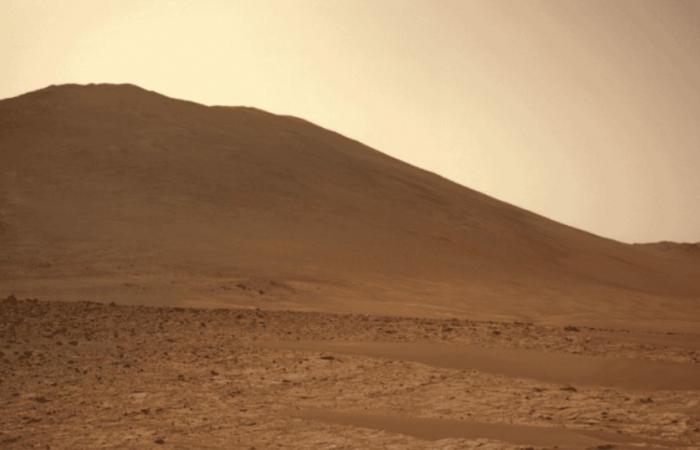On May 20, data from the European Solar Orbiter spacecraft showed that an estimated X12 solar flare, the strongest type on the flare classification scale, emerged from sunspot AR3664, which was renamed AR3697 in its second trip around the sun. A powerful coronal mass ejection (CME) followed, sending a huge cloud of superhot solar plasma towards Mars at millions of kilometers per hour.
The impacts of this solar event provided important data for scientists watching how it all unfolded. Researchers from NASA’s MAVEN orbiter, the Mars Odyssey 2001 orbiter and the Curiosity Mars rover played key roles in capturing data from the event that will help us better understand our neighboring planet and plan future manned visits to it, according to the media. specialized Space.com.
“Really we got the full range of space weather conditions on Mars from May 11 to 20, from large flares, CMEs, and an extreme solar energy particle burst, and we’ve only just begun to scratch the surface analyzing the data. The May 14 flare really delivered as expected,” Ed Thiemann, a heliophysicist at the Laboratory for Atmospheric and Space Physics (LASP) at the University of Colorado, Boulder, told Space.com in an email.
“The flare significantly inflated and heated Mars’ atmosphere as expected, and the resulting CME did indeed produce auroras,” Thiemann added.
MAVEN (short for “Mars Atmosphere and Volatile Evolution”) had a front-row seat to the spectacular aurora display over Mars. But the way auroras are created in the Martian atmosphere is very different from what happens here on Earth.
The Earth has a magnetic field that protects us from charged particles. This field channels these particles toward the poles, which is why auroras are normally only visible from high latitudes. Mars, on the other hand, lost its magnetic field in ancient times and is therefore not protected from these particles. So when the particles hit Mars’ atmosphere, the resulting auroras spread across the planet.
Curiosity’s Radiation Assessment Detector (RAD) instrument can capture the most energetic particles, which reach the surface of the Red Planet, but it is the least energetic ones that create the impressive auroras. That’s where MAVEN’s Solar Energetic Particle instrument comes in, allowing scientists to measure the energy the aurora creates and recreate the event.
“This was the largest solar-powered particle event MAVEN has ever seen”Christina Lee, MAVEN space weather lead at the University of California, Berkeley, Space Sciences Laboratory, said in a recent NASA statement. “There have been several solar events in recent weeks, so we were seeing wave after wave of particles hitting Mars.”
Curiosity’s RAD instrument also played an important role, gathering information to better educate scientists about how solar storms cause impacts on the Martian surface.
Meanwhile, when Odyssey encountered the energetic particles in Mars orbit, its star camera (used to orient the orbiter) took a hit and was momentarily offline. Even with the brief setback, the orbiter was still able to gather details about charged particles as well as X-rays and gamma rays with its high-energy neutron detector. And it is not only technology that can observe this phenomenon from particle explosions; humans can do it too.
“The ‘specks’ and ‘streaks’ observed in the camera aboard Curiosity are not far from what astronauts see when their eyes are bombarded by radiation storm particles. In fact, astronauts aboard the ISS often describe seeing ‘fireworks’ when they close their eyes during radiation storms,” Tamitha Skov, a retired Aerospace Corporation research scientist and professor of space meteorology at Millersville University in Pennsylvania, told Space.com in an email.
“This is because an energetic particle deposits some energy when it passes through the CCD sensor of a camera or the retina of the eye, and that deposited energy causes a false signal, causing the camera or eye to mistakenly believe that they are seeing a speck or a ray of light,” Skov added.
Live on Mars
Scientists say so much radiation would not be fatal to humans, but it still serves to remind us that future visitors to the red planet will need to be adequately protected. The information collected provided a better understanding of How Mars astronauts can be kept safe in the event of powerful solar storms, the researchers said.
“Cliffs or lava tubes would provide additional protection for an astronaut against such an event. In Mars orbit or deep space, the dose rate would be significantly higher,” Don Hassler, RAD principal investigator at the Southwest Research Institute Solar System Science and Exploration Division. in Boulder, Colorado, said in the same NASA statement.
In addition to the safety of humans on the red planet, Scientists are also concerned about agricultural development. Powerful solar storms like last month’s could make it difficult to plant and grow enough food in the planet’s already challenging environment.
“Since growing plants requires sunlight, energy and a lot of space, it will be difficult to grow enough food in lava tubes or caves, even if colonists can supply enough artificial light to sustain their growth,” Skov said. “Unlike Earth, Mars’ atmosphere is so thin that energetic particles can penetrate to the ground. This means that Radiation storms, in one form or another, are a constant problem. They are like a light drizzle that falls incessantly on the surface, all the time.”
As sunspot region AR3697 makes its second appearance in front of Mars, researchers are eagerly awaiting the opportunity to see what else they can learn from this sunspot that just doesn’t want to leave. “This same sunspot group is still active and rotating toward Mars this week, and may provide more events that will aid our understanding of the evolution and loss of the Martian atmosphere,” Thiemann said.






